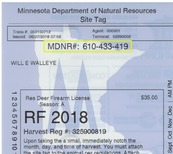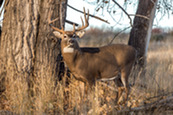|
Having trouble viewing this email? View it as a Web page.
November 1, 2023
St. Paul, MN - This fall, deer across Minnesota, and other states, may be tested for Chronic Wasting Disease (CWD) as part of surveillance programs. Hunters and meat processors can take the following important steps to help ensure their deer are handled safely and that any concerns regarding the wholesomeness or safety of their meat is properly addressed.
 |
|
- Follow all Department of Natural Resources (DNR) deer movement, import and testing requirements.
- Dispose of any meat that is not wholesome or safe.
- Review and document the MDNR number (top section of their DNR Site Tag) for all incoming deer.
- Know the testing status, including whether results are available for deer dropped off for processing.
|
Ask for CWD Test Results and Respond
When hunters drop off their deer carcasses (or trim) at your establishment, ask the hunter if the carcass has been sampled/tested for CWD. Then, ask if they have the CWD results!
If the hunter tested the carcass but does not have the results, choose one of these options:
- Hold carcass or venison trim until results are available; OR
- Debone the carcass at the end of the production day; separate and hold trim until results are available; OR
- Break carcass into primals and store until results are available.
The processor will also need to:
- Process tested deer separate from other deer to ensure there is no cross contamination between carcasses. This would include cleaning and sanitizing equipment between deer.
- Establish communication with the hunter to obtain test results, and discuss whether the hunter still wants the carcass or trim if it is positive for CWD.
- Monitor the CWD test results, located here.

Processors should use best practices for addressing CWD if they are handling carcasses with an unknown (or positive) test result. MDA recommends proper cleaning and sanitizing at the end of the production day or between handling deer carcasses with pending CWD results. Using a proper sanitizer at the correct concentrations can be an effective way to reduce the risk of CWD cross contamination. Options for sanitation can be found here.
Processors should also avoid batching for ground product or cooking/smoking unless the entire batch contains negative CWD test results for trim or carcasses.
|
 |
|
If results are positive for CWD:
- Verify that the hunter still wants the carcass and/or trim.
- Dispose of the carcass (or trim) properly if the hunter elects not to keep the meat. Carcasses need to be disposed of per the DNR disposal requirement. Review disposal requirements.
- Process the deer separately from all others if the hunter elects to continue with processing. Pay strict attention to cleaning and sanitation guidelines for addressing CWD contamination to avoid cross contamination and DO NOT batch process with other carcasses or trim.
If the hunter has tested the carcass and has negative (“not detected”) CWD results:
- Process the carcass or trim as normal.
|
If the hunter has not sampled the carcass for CWD and was required to do so (deer was harvested in CWD management and surveillance zones):
- You should not accept the deer and refer the hunter to the resources below.
- Refer them to the DNR CWD testing requirements.
-
Contact the MN DNR Wildlife Area Contacts via this link.
Additional CWD resources can be found on the MN DNR website.
|